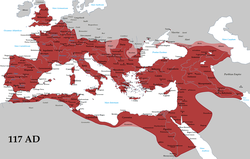Imperyong Romano
Roman Empire
| |
|---|---|
 | |
 Roman territorial evolution from the rise of the city-state of Rome to the fall of the Western Roman Empire | |
| Estado | Empire |
| Kapitolyo |
|
| Relihiyon |
|
| Demonym | Roman |
| Gobyerno | Semi-elective absolute monarchy (de facto) |
• Emperor | (List) |
| Currency | Sestertius,[lower-alpha 4] aureus, solidus, nomisma |
An Imperyong Romano[17] iyo an post-Republican na estado kan suanoy na Roma asin iyo an pangkagabsan na nasasabotan tanganing mangahulogan na an peryodo asin teritoryo na pigpamayuhan kan Romans suminunod sa asumpsyon ni Octavian kan solong pagpamayo sa irarom kan Prinsipato kaidtong 31 BC. Kabali diyan an teritoryo sa Europa, Amihanan na Aprika, asin Solnopan na Asya, asin pigpamayuhan kan mga emperador. An pagbagsak kan Imperyong Solnopan na Romano kaidtong 476 conventionally minarkahan an katapusan kan classical antiquity asin an kapinonan kan Middle Ages.
Toltolan
- ↑ 1.0 1.1 Ancient Rome: The Definitive Visual History (in English). Dorling Kindersley Limited. 2023. p. 276. ISBN 978-0-241-63575-9.
- ↑ Classen, Albrecht (2010). "The changing shape of Europe". Handbook of Medieval Studies: Terms – Methods – Trends (in English). Walter de Gruyter. ISBN 978-3-11-021558-8.
Constantine the Great transferred the capital of the Roman Empire from Rome to the newly-founded city of Constantinople
- ↑ Price, Jonathan J.; Finkelberg, Margalit; Shahar, Yuval (2022). Rome: An Empire of Many Nations (in English). Cambridge University Press. p. 19. ISBN 978-1-009-25622-3.
the capital of the Empire was transferred from Rome to Constantinople in the fourth century
- ↑ Erdkamp, Paul (2013). The Cambridge Companion to Ancient Rome (in English). Cambridge University Press. p. 202. ISBN 978-0-521-89629-0.
Constantine sounded the death knell for Rome as a vital political centre with the dedication of his new imperial capital at Constantinople
- ↑ Bjornlie, M. Shane (2013). Politics and Tradition Between Rome, Ravenna and Constantinople: A Study of Cassiodorus and the Variae, 527–554 (in English). Cambridge University Press. p. 41. ISBN 978-1-107-02840-1.
As a new capital, Constantinople provided a stage for imperial prestige that did not depend on association with the traditions of the senatorial establishment at Rome
- ↑ Coffler, Gail H. (2004). Melville's Allusions to Religion: A Comprehensive Index and Glossary: A Comprehensive Index and Glossary (in English). ABC-CLIO. p. 181. ISBN 978-0-313-07270-3.
It became Constantinople, capital of the entire Roman Empire
- ↑ Maxwell, Kathleen (2016). "Art and Diplomacy in Late Thirteenth-century Constantinople: Paris 54 and the Union of Churches". Between Constantinople and Rome: An Illuminated Byzantine Gospel Book (Paris gr. 54) and the Union of Churches (in English). Routledge. ISBN 978-1-351-95584-3.
Constantine the Great, the emperor who moved the capital of the Roman Empire from Rome to Constantinople
- ↑ Grig, Lucy; Kelly, Gavin (2012). Two Romes: Rome and Constantinople in Late Antiquity (in English). Oxford University Press. p. 237. ISBN 978-0-19-992118-8.
- ↑ Loewenstein, K. (2012). The Governance of ROME (in English). Springer. p. 443. ISBN 978-94-010-2400-6.
- ↑ Harris, Jonathan (2009). Constantinople: Capital of Byzantium (in English). A&C Black. p. 31. ISBN 978-0-8264-3086-1.
- ↑ Treadgold (1997), p. 734.
- ↑ Tricht, Filip Van (2011). The Latin Renovatio of Byzantium: The Empire of Constantinople (1204–1228) (in English). Brill. pp. 61–82. ISBN 978-9004203235.
- ↑ Bennett (1997).
- ↑ 14.0 14.1 14.2 Taagepera, Rein (1979). "Size and Duration of Empires: Growth-Decline Curves, 600 B.C. to 600 A.D". Social Science History 3 (3/4): 125. doi:.
- ↑ Turchin, Peter; Adams, Jonathan M.; Hall, Thomas D. (2006). "East-West Orientation of Historical Empires". Journal of World-Systems Research 12 (2): 222. Archived from the original on 2016-05-17. http://arquivo.pt/wayback/20160517210851/http://peterturchin.com/PDF/Turchin_Adams_Hall_2006.pdf. Retrieved on 2023-10-20.
- ↑ Durand, John D. (1977). "Historical Estimates of World Population: An Evaluation". Population and Development Review 3 (3): 253–296. doi:. http://repository.upenn.edu/cgi/viewcontent.cgi?article=1009&context=psc_penn_papers.
- ↑ Wolff, Robert Lee (1948). "Romania: The Latin Empire of Constantinople". Speculum 23 (1): 1–34, especially 2–3. doi:.
Preview of references
- ↑ Cite warning:
<ref>tag with namefnothercannot be previewed because it is defined outside the current section or not defined at all. - ↑ In 286, Emperor Diocletian divided the Roman Empire into two administrative units–East and West–an arrangement that periodically returned until the two halves were permanently divided in 395.[1] Although the halves were independent in practice, the Romans continued to consider the Roman Empire to be a single undivided state with two co-equal emperors until the fall of the western half in 476/480.[1] Although emperors at times governed from other cities (notably Mediolanum and Ravenna in the West and Nicomedia in the East), Rome remained the de jure capital of the entire Roman Empire until Emperor Constantine I transferred the capital to Constantinople ("New Rome") in 330, henceforth the new capital of the entire empire.[2][3][4][5][6][7] For a time, mostly over the course of the later decades of the fourth century, Rome continued to hold greater symbolic status on account of its greater antiquity as imperial capital.[8] From at least 361 onwards, senators belonging to the new senate in Constantinople enjoyed the same status and privileges as senators of the Roman Senate, to which the new senate was largely identical.[9] By 450, Constantinople was much grander in size and adornment than Rome and unquestionably senior in status.[10]
- ↑ In 1204, the crusaders of the Fourth Crusade captured Constantinople and established the Latin Empire. The city remained under foreign rule until 1261, when it was captured by the Empire of Nicaea (a Byzantine/Roman successor state). Nicaea is usually considered the "legitimate" continuation of the Roman Empire during the "interregnum" 1204–1261 (over its rivals in Trebizond and Thessalonica) since it managed to retake Constantinople.[11] Whether there was an interregnum at all is debatable given that the crusaders envisioned the Latin Empire to be the same empire as its predecessor (and not a new state).[12]
- ↑ Abbreviated "HS". Prices and values are usually expressed in sesterces.
- ↑ Fig. 1. Regions east of the Euphrates river were held only in the years 116–117.

